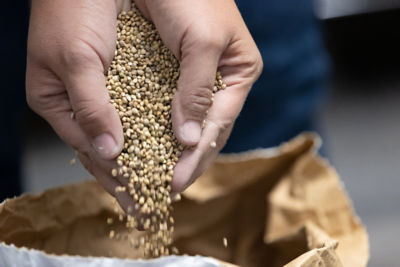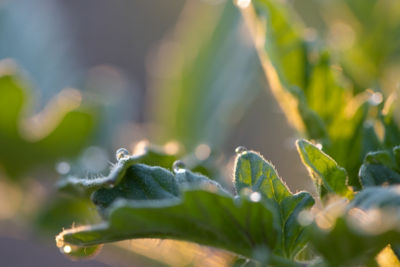Click here to download a PDF version of this spotlight.
» Under disease favorable conditions, Phytophthora blight of melons can result in substantial yield losses.
» Symptoms may be first observed on fruits and leaves, but stems, crowns, and roots can also be infected.
» The integration of cultural control practices and fungicide applications is recommended for managing Phytophthora blight on melons.
Phytophthora blight of melon is primarily caused by the oomycete pathogen Phytophthora capsici, but other species of Phytophthora can also be involved.1,2 The disease is considered one of the most important diseases of cucurbit crops in many regions due to its potential for rapid plant-to-plant spread and substantial yield losses.3 Phytophthora capsici has a wide host range, affecting almost all cucurbit species, as well as pepper, eggplant, tomato, and succulent beans (snap, lima, etc.)4
P. capsici can affect cucurbit plants at any growth stage and infect roots, crowns, stems, leaves, and fruit. Sometimes the root and crown rot phases are called Phytophthora root and crown rot, but the term Phytophthora blight can be used for any phase of the disease. Melons/cantaloupes are usually less severely affected by Phytophthora blight than are other cucurbits, such as squash and pumpkin.1,2,5,6
SYMPTOMS
Symptoms of Phytophthora blight can develop on all aboveground plant parts of the melon plant with symptoms on the fruit being most common (Figure 1).3,5 Lesions on the stems, leaves, and crown may develop before fruit rot symptoms (Figure 2). The initial symptom is the formation of a watersoaked spot or lesion on the fruit surface, usually where the fruit is in contact with the soil. Inoculum splashing onto the upper surface of the fruit can sometimes result in lesions developing in those areas first.2 The fruit lesions may become covered with a white, yeast-like growth that resembles powdered sugar. Under moist conditions, this growth can cover the entire fruit surface.2,4 Fruit symptoms may develop several days after infection, meaning that they may not appear until after harvest.
 Figure 1. The effect of pH on the plant availability of three secondary macronutrients.
Figure 1. The effect of pH on the plant availability of three secondary macronutrients.

Crown and root rot symptoms can develop on melons in some situations. When root and crown tissues are affected, sudden and permanent wilt can occur within a few days of initial symptom formation. Affected tissues often become soft, water-soaked, and may turn light- to dark-brown, but wilting can occur with no discoloration of the affected tissues (Figure 2). Stems can collapse but the leaves stay green for a time.1,4,6
CYCLE AND CONDITIONS
Phytophthora capsici is an oomycete organism and not a true fungus. Most oomycetes live in water and are often referred to as “water molds”. These organisms often do well in areas with poor drainage and proliferate after heavy rains or in areas with standing water. They can survive in bodies of water (ponds, rivers, streams) for extended periods. P. capsici can survive in soil and crop debris for more than ten years and can also survive on the roots of susceptible weed species including purslane, jimson weed, and nightshade.1,2,3,6 The pathogen forms structures called sporangia, which can be disseminated by splashing rain and irrigation water. The sporangia germinate in the presence of water (films on plant surfaces), releasing 20 to 40 swimming zoospores, which can infect the plant. Sporangia can also germinate to form a germ-tube, which can infect the plant directly.1 Infection is favored by wet conditions such as overhead irrigation, heavy rain, and poor soil drainage. Dispersal patterns are often associated with the directions of water flow within the field, such as down a row. Younger plants are usually more susceptible to Phytophthora blight infection and wounding can increase the likelihood of infection.1,2,6,7 Infection is also favored by soil temperatures above 65°F and air temperatures from 75° to 85°F.3,6
MANAGEMENT
Because of the wide host range of Phytophthora capsici and the ability of the pathogen to survive in soil for over 10 years, Phytophthora blight of melon can be difficult to manage. No disease resistance against Phytophthora blight is currently available in melon, though there may be differences in susceptibility among melon types and varieties.1,3 Crop rotation away from susceptible crops for at least four years is recommended. Rotation may not be effective in reducing inoculum of P. capsici in the soil, but avoiding the use of susceptible crops, including pepper, tomato, eggplant, green beans, and other cucurbits may help prevent further increases in inoculum levels.3 Integrating cultural control practices with the use of fungicides is recommended for managing Phytophthora blight on melon. Relying solely on fungicide applications will usually not result in sufficient levels of control.1,3,6
Regularly scout fields for symptoms of Phytophthora blight beginning early in the season, especially following periods with wet weather and warm temperatures.4
Inoculum (sporangia) of P. capsici is spread by moving and splashing water. So, use drip irrigation when possible and avoid using overhead irrigation and planting in fields with poor drainage. If overhead irrigation can’t be avoided, water early in the day to give the plants time to dry before sunset, minimizing the time plants are exposed to free moisture. Avoid using surface sources of water (ponds, streams, rivers) for irrigation, as pathogen inoculum may be present in water from these sources.1,2,3
Planting on raised beds covered with plastic mulch helps promote drainage and prevent the splashing of inoculum in the soil up onto stems, leaves, and fruit. However, plastic mulched raised beds will not protect from splashing inoculum once the vines grow into the non-mulched, between-row areas. Low areas of the mulched beds can also retain water, and fruit that develop in or near those areas may be more likely to become infected. Sub-soiling the field to disrupt hardpans can also help improve drainage.2,3
To help prevent introduction of the pathogen into noninfested fields, practice good sanitation. Thoroughly clean all equipment between use in infested and non-infested fields, removing all soil and crop debris. Additionally, clean tools and workers shoes before entering non-infested fields. When possible, work in infested fields last.1,2,4 If the disease develops in the field, remove the infected plants and the adjacent, healthy-looking plants to help reduce the buildup of inoculum. Do not dispose of any infected plant debris, including culled fruit, in the production field.2,3,4
Applying fungicides can help slow disease spread and development; however, if used as the only management practice they may not provide acceptable control, especially under conditions of high disease pressure (extremely favorable conditions for disease).1 Melons are mostly susceptible to leaf and fruit infections, so fungicide applications should focus on protecting those tissues.3 Because P. capsici is an oomycete organism and not a true fungus, fungicides that are effective against fungal pathogens (anthracnose, gummy stem blight, powdery mildew) may not be effective against Phytophthora blight. Select fungicide products that show activity against oomycetes. Fungicide products that contain active ingredients such as cyazofamid, cymoxanil, dimethomorph, fluopicolide, mandipropamid, mefenoxam, oxathiapiprolin, or zoxamide are usually recommended to help manage oomycete pathogens.2
Resistance to some fungicides, including cyazofamid and mefenoxam, have been observed in populations of P. capsici. Consult local and regional vegetable disease management guides for the most current recommendations on fungicides to use for managing Phytophthora blight on melons in your area. Alternate applications of fungicide products that contain active ingredients from different FRAC groups to help prevent the development of fungicide resistant strains of the pathogen.1,2,4 Always consult the most current fungicide product label and follow the application instructions and restrictions listed on the label.
SOURCES
M. and Quesada-Ocampo, L. 2017. Phytophthora crown and root rot. In Keinath, A., Wintermantel, W., and Zitter, T., Eds. Compendium of Cucurbit Diseases and Pests, Edition. American Phytopathological Society, pp 43-45.
2McGrath, M. 2017. Phytophthora fruit rot. In Keinath, A., Wintermantel, W., and Zitter, T., Eds. Compendium of Cucurbit Diseases and Pests, Second Edition. American Phytopathological Society, pp 102-104.
3Egel, D. 2020. Managing Phytophthora blight of cucurbits. Purdue University Botany and Plant Pathology. PB-204-W. https://www.extension.purdue.edu/extmedia/bp/bp-204-w.pdf.
4Hausbeck M. and Linderman, S. 2016. Managing Phytophthora on cantaloupe, muskmelon, and watermelon. Michigan State University Extension. https://veggies.msu.edu/wp-content/uploads/2025/03/Managing-Phytophthora-on-Cantaloupe-Muskmelon-and-Watermelon.pdf.
5McGrath, M. 2023. Phytophthora blight and its management in cucurbit crops and other vegetables. Cornell University, Cornell Vegetables. https://www.vegetables.cornell.edu/pest-management/disease-factsheets/phytophthorablight- and-its-management-in-cucurbit-crops-and-other-vegetables/.
6Kurowski, C., Conn, K., Lutton, J., and Rosenberger, S. 2015. Cucurbit disease field guide. Seminis/De Ruiter. https://www.vegetables.bayer.com/us/en-us/resources/disease-guides.html.
7Quesada-Ocampo, L. 2024. Are your cucurbits infected with Phytophthora capsici? North Carolina State Extension, Extension Plant Pathology. https://plantpathology.ces.ncsu.edu/2013/08/are-your-cucurbits-infected-with-phytophthoracapsici/.
Websites verified 7/10/2025
ADDITIONAL INFORMATION
For additional agronomic information, please contact your local seed representative. Performance may vary, from location to location and from year to year, as local growing, soil and environmental conditions may vary. Growers should evaluate data from multiple locations and years whenever possible and should consider the impacts of these conditions on their growing environment. The recommendations in this article are based upon information obtained from the cited sources and should be used as a quick reference for information about vegetable production. The content of this article should not be substituted for the professional opinion of a producer, grower, agronomist, pathologist and similar professional dealing with vegetable crops.
BAYER GROUP DOES NOT WARRANT THE ACCURACY OF ANY INFORMATION OR TECHNICAL ADVICE PROVIDED HEREIN AND DISCLAIMS ALL LIABILITY FOR ANY CLAIM INVOLVING SUCH INFORMATION OR ADVICE.
6411_567150 Published 06/12/2025




